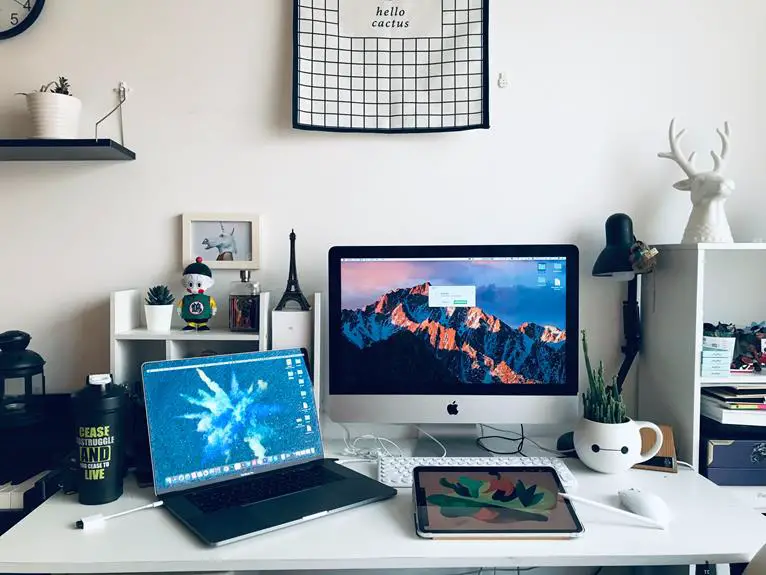Hey there, wondering if dual screen ergonomics are a must for your home office setup? Let's dive in.
Mastering your workspace for optimal productivity is crucial, and dual screen ergonomics can take your efficiency to the next level. With the right setup, you can enhance your multitasking abilities and reduce strain on your body.
So, are dual screen ergonomics essential for a home office? Let's explore the advantages and best practices to ensure you're making the most of your dual screen setup.
Key Takeaways
- Dual screen ergonomics enhance productivity and multitasking abilities.
- Dual screen setup reduces strain on the body and improves workspace organization.
- Proper monitor placement, uncluttered desk setup, and regular breaks are essential for dual screen ergonomics.
- Optimizing dual screen ergonomics includes maintaining proper distance between monitors, using an adjustable chair, organizing cables, and taking regular breaks to rest the eyes and stretch the body.
The Importance of Dual Screen Ergonomics
You should prioritize the importance of dual screen ergonomics to minimize strain and enhance productivity in your home office.
By investing in a well-organized workspace that's optimized for dual screen use, you can experience significant productivity benefits. Proper dual screen ergonomics can help you streamline your workflow, allowing you to multitask efficiently and seamlessly transition between different tasks. This setup enables you to have multiple applications and documents open simultaneously, eliminating the need to constantly switch between tabs or windows, thus saving time and boosting your overall productivity.
Workspace organization is crucial for maintaining a productive and comfortable home office environment. With dual screen ergonomics, you can arrange your screens to suit your workflow, making it easier to access the information you need without unnecessary strain. Additionally, a well-organized workspace contributes to a more visually appealing and professional environment, which can positively impact your mindset and motivation.
In essence, prioritizing dual screen ergonomics in your home office offers substantial productivity benefits and promotes workspace organization, ultimately leading to a more efficient and comfortable work experience.
Advantages of Dual Screen Setup
When considering a home office setup, the advantages of a dual screen configuration become evident for enhancing productivity and minimizing strain. With a dual screen setup, you can enjoy the following benefits:
- Enhanced Productivity: By having multiple screens, you can work on different tasks simultaneously, such as referencing information on one screen while working on a document on the other. This reduces the need to switch between tabs or windows, ultimately saving time and improving efficiency.
- Improved Multitasking: Dual screens allow you to multitask more effectively, such as participating in a video conference on one screen while reviewing relevant documents on the other.
- Workspace Flexibility: With dual screens, you have the flexibility to customize your workspace according to your specific needs, whether it's comparing data, coding, designing, or any other task that requires access to multiple sources of information.
- Reduced Neck and Eye Strain: By spreading out your workload across two screens, you can reduce the need to constantly shift focus or strain your neck by turning back and forth between different applications.
- Streamlined Workflow: A dual screen setup can streamline your workflow, making it easier to organize and access information, resulting in a more efficient work process.
Ergonomic Considerations for Dual Screens
Considering the advantages of a dual screen setup, it's crucial to address ergonomic considerations for ensuring comfort and minimizing potential health issues associated with prolonged screen use.
When setting up dual monitors, proper monitor placement is essential to reduce eye strain. Position the monitors at eye level, about an arm's length away, and ensure that the screens are directly in front of you to minimize neck and eye movement.
Desk setup is equally important. Keep the deskspace uncluttered, allowing for a comfortable viewing distance and preventing unnecessary strain on your neck and back.
Additionally, maintaining good posture is vital. Sit upright with your back supported and your feet flat on the floor. Consider using an adjustable chair and keyboard tray to achieve the optimal ergonomic position.
Remember to take regular breaks to stand, stretch, and rest your eyes. By implementing these ergonomic principles, you can create a workspace that promotes comfort, reduces strain, and supports your overall well-being.
Tips for Optimizing Dual Screen Ergonomics
To optimize dual screen ergonomics in your home office, ensure that each monitor is positioned at eye level and directly in front of you to minimize strain on your neck and eyes. In addition to proper monitor placement, here are five essential tips for optimizing dual screen ergonomics:
- Maintain Proper Distance: Position your monitors an arm's length away to reduce eye strain and minimize the need for constant refocusing.
- Use an Adjustable Chair: Invest in an ergonomic chair with adjustable armrests and lumbar support to maintain proper posture and reduce strain on your back and shoulders.
- Organize Cables: Keep cables and cords neatly organized and out of the way to prevent tripping hazards and maintain a clean workspace setup.
- Adjust Brightness and Contrast: Set your monitor brightness and contrast to comfortable levels to reduce eye fatigue and minimize glare.
- Take Regular Breaks: Incorporate short breaks into your work routine to rest your eyes and stretch your body, reducing the risk of repetitive strain injuries and maintaining overall productivity.
Dual Screen Ergonomics Best Practices
Incorporate a dual screen setup that prioritizes ergonomic best practices to enhance your home office productivity and comfort.
Start by optimizing your workspace setup. Position your primary screen directly in front of you at eye level to reduce neck strain. Place the secondary screen off to the side, at the same height as your primary screen, to minimize head movements. Ensure that both screens are at arm's length, allowing you to maintain a relaxed posture while working.
When it comes to screen positioning, angle the screens slightly inward to create a seamless viewing experience without straining your neck or eyes. Adjust the brightness and contrast settings to reduce glare and eye fatigue.
Additionally, use a dual monitor stand to free up desk space and maintain a clean, organized setup. Cable management is crucial to prevent tripping hazards and maintain a clutter-free environment.
Frequently Asked Questions
What Are the Potential Health Risks of Using a Single Screen in a Home Office Setup?
Using a single screen setup in your home office may lead to potential health risks like eye strain and fatigue, impacting productivity and efficiency. To avoid this, consider dual screen ergonomics for a more comfortable working environment.
How Can Dual Screen Ergonomics Improve Productivity and Efficiency in a Home Office Environment?
To maximize productivity and efficiency in a home office, dual screen ergonomics offer a significant advantage. With a dual screen setup, you can seamlessly multitask, access multiple applications simultaneously, and streamline your workflow for enhanced performance.
Are There Any Specific Ergonomic Guidelines for Setting up Dual Screens in a Home Office?
When setting up dual screens in a home office, ergonomic guidelines are crucial for your comfort and productivity. Ensure proper screen height, distance, and angles to reduce strain on your neck, back, and eyes.
Can Dual Screen Ergonomics Help Reduce Eye Strain and Fatigue During Long Work Hours?
To reduce eye strain and fatigue during long work hours, proper screen positioning and lighting are essential. Maintaining good posture is also crucial. Dual screen ergonomics can greatly improve your comfort and productivity in a home office.
Are There Any Recommended Accessories or Tools That Can Enhance Dual Screen Ergonomics in a Home Office?
To enhance dual screen ergonomics in your home office, recommended accessories like monitor stands, cable management tools, and ergonomic chairs can improve your setup. Desk organization and lighting solutions also play a crucial role in creating a comfortable work environment.



